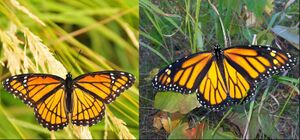Mimicry

Mimicry is the similar appearance of an animal or plant to another animal, plant, or inanimate object.
The monarch butterfly, for example, adapted to eating milkweed which made it poisonous to its predators and later evolved to have bright colors to identify its toxicity to other animals. Unlike the monarch, the viceroy butterfly does not eat milkweed and is non-toxic. The viceroy however evolved using mimicry of the monarch butterfly to make predators believe it is toxic.[1] Mimicry does have limitations, where both the monarch and viceroy would loose its protection if the non-toxic viceroy butterfly became to prolific and predators no longer associated its markings as toxic.[1]
Exact duplication is not required for mimicry to be successful, and the purpose of the mimic may have its own purpose different from the original. It is important to identify how much and what kind of mimicry is required to gain the desired advantage.[1]
Forest gardens use mimicry to emulate deciduous forests.[1]
References
- ↑ 1.0 1.1 1.2 1.3 Jacke, Dave, and Eric Toensmeier. Edible Forest Gardens, Volume One. Chelsea Green Publishing, 2005. pp 26-25.